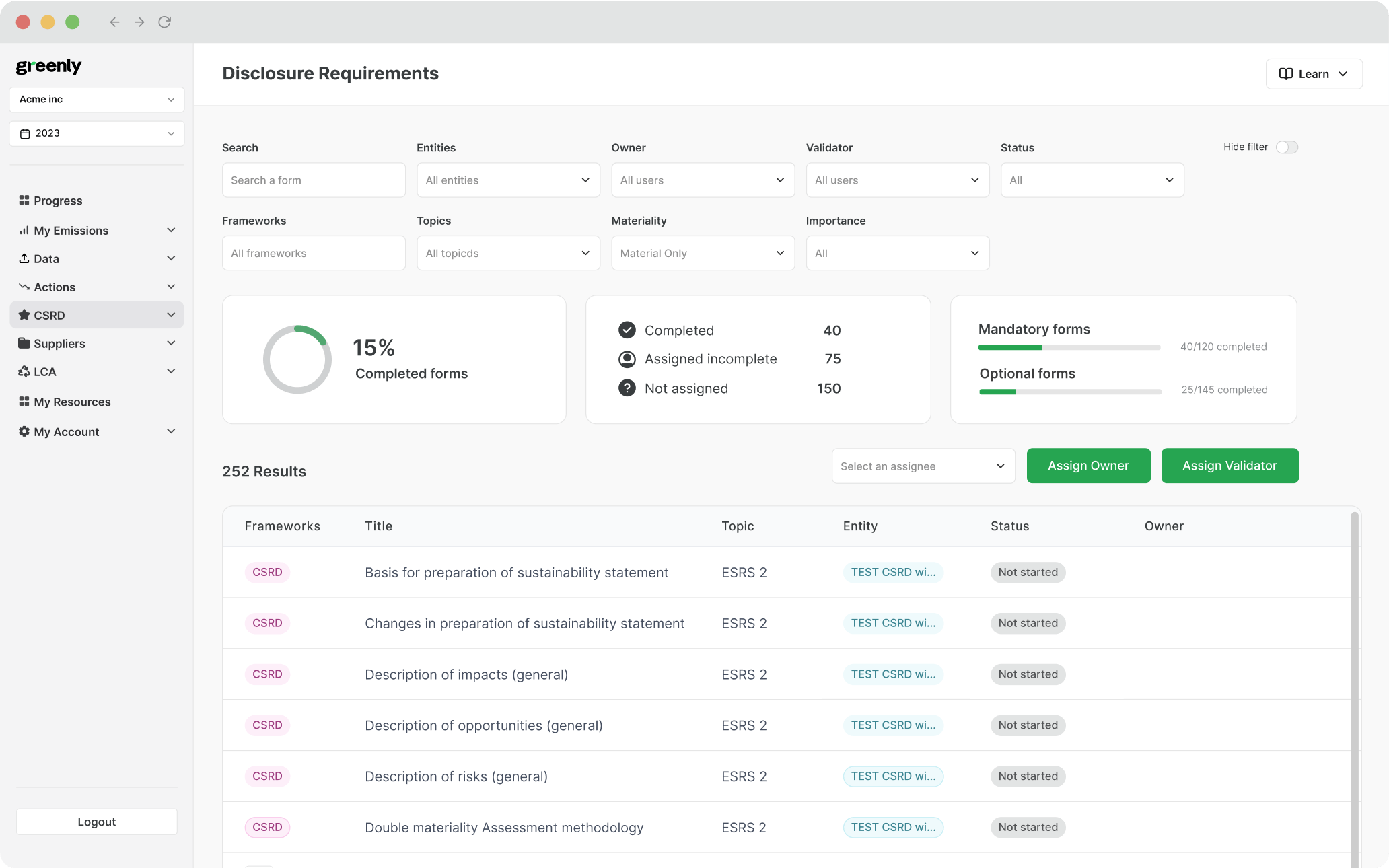
What are the 3 Pillars of Corporate Sustainability?
In this article, we'll explore what the 3 pillars of corporate responsibility are, why they're important, and how businesses can turn them into practical action.
ESG / CSR
Industries



Reducing emissions remains the priority for any credible sustainability strategy, but many companies still turn to carbon offsets to address the impact they can’t fully eliminate. This guide explains what carbon offsets are, how they work in practice, and the role they can play alongside wider emissions reduction efforts, including the limitations to keep in mind.
We break down what carbon offsets are (and what they aren’t)
How they differ from carbon credits
When they can support a wider emissions reduction strategy
The key limitations to keep in mind
A carbon offset is simply a way to balance out emissions that you can’t avoid. Instead of being a licence to keep polluting, it’s a financial contribution to projects that actively reduce or remove greenhouse gases - like reforestation, renewable energy, or community energy-efficiency programmes.
Many of these projects take place in lower-income regions, where they can deliver more than just carbon benefits. Alongside emissions reductions, they often support local livelihoods, protect ecosystems, and improve access to cleaner energy or technology.
You’ve likely heard the terms carbon offset project and carbon offset credits used as if they mean the same thing, but they don’t. Read on to find out how to tell them apart.
To put this into perspective, imagine a consulting firm that often flies overseas to meet clients. Before booking those trips, the obvious first question is whether they’re genuinely necessary - could the same outcome be achieved over video instead? Cutting travel where it isn’t essential immediately reduces emissions and keeps day-to-day practice in line with sustainability goals.
When travel really is unavoidable, that’s where carbon offsets come in. Each time a consultant needs to fly, the company could support projects like reforestation or renewable energy to balance out the emissions from that flight.
Offsetting doesn’t replace the work of reducing emissions at the source, but it can help account for the impact of those trips that can’t realistically be cut.
Once a company has done everything it reasonably can to cut its own emissions, offsetting comes into play for what’s left. Instead of managing projects directly, most organisations work with a certified offset provider who connects them to credible climate initiatives. Whether that’s restoring damaged ecosystems, improving energy access, or funding methane capture.
1. Calculate your carbon footprint
2. Choose verified projects that match your remaining impact
3. Contribute funding proportionate to those emissions
Rather than being a theoretical gesture, that money translates into real activity on the ground: tree cover restored, clean cookstoves distributed, landfill methane captured, solar infrastructure installed, and so on.
Offsets don’t replace the need to keep reducing emissions, but they can support climate action beyond a company’s own boundaries.
Carbon offset projects don’t follow a one-size-fits-all model. Many offset standards and issuers organise them into two broad buckets: “avoidance/reduction” (projects that prevent emissions from happening) and “removal/sequestration” (projects that take CO₂ out of the atmosphere).
Inside those buckets, there are dozens, sometimes hundreds, of different project types. Some databases catalogue over 200 distinct kinds of activities that qualify for carbon credits or offsets!
To keep things simple, we'll focus on the most common and widely used categories. But it’s worth remembering: the carbon-offset landscape is diverse and constantly evolving - what you pick can meaningfully affect both climate effectiveness and social impact.
Carbon offsetting sits in a tricky middle ground. On one hand, it channels money into climate projects that might otherwise struggle to get funded. On the other, a growing body of evidence shows that many credits have delivered far less climate impact than advertised.
Recent investigations into rainforest offset programmes found that many issued credits didn’t actually translate into real, measurable emissions reductions. A 2024 study in Nature Communications went further, estimating that less than 16% of the credits they assessed reflected genuine, additional emissions cuts, with big variations between project types. There's growing concern that the offset industry is guilty of over-promising on climate impact while letting companies lean on cheap credits instead of actually cutting their own emissions.
At the same time, it would be an oversimplification to say all offsets are useless. Some projects - like certain industrial gas destruction projects or well-designed forest and community initiatives - have been shown to deliver real, measurable climate benefits and important community benefits. The problem is inconsistency.
This is why there’s now such a strong push for reform rather than abandonment. The Integrity Council for the Voluntary Carbon Market (ICVCM) has introduced its Core Carbon Principles (CCPs) to define what “high-quality” should look like, and has started approving major registries against these rules, covering the vast majority of the current market.
While the Voluntary Carbon Markets Integrity Initiative (VCMI) has published a Claims Code and a Scope 3 Action Code, which set guardrails for how companies can use credits, and how much, alongside deep emissions cuts, rather than instead of them.
So, how much does offsetting help? The honest answer is: it depends hugely on the quality of the credits and what else the company is doing. Used well, high-integrity offsets can direct finance to valuable climate and community projects, especially in the Global South. Used badly, they risk over-stating climate progress, delaying real emissions reductions, and in some cases even enabling harmful practices behind a “green” label.
This is why offsets should sit behind, not in front of, a robust reduction strategy. Companies need to focus first on cutting emissions at the source, then use carefully chosen, high-quality offsets to address the residual impact they can’t yet eliminate.
Carbon offsets aren’t a shortcut to sustainability, but they can play a useful supporting role when reductions have already been pushed as far as they reasonably can. At their best, they direct funding toward climate projects that need it, especially in regions where financing is limited or slow to arrive.
Some of the key benefits include:
Environmental restoration
Supports ecosystem repair and reforestation, helping store carbon and protect biodiversity.
Clean energy support
Funds renewable power where fossil fuels still dominate, expanding access to cleaner energy.
Community impact
Improves local living conditions through clean cooking, better air quality, and fair job creation.
Energy efficiency
Backs projects that reduce energy waste, cutting emissions by simply using less.
Awareness & engagement
Encourages companies to measure their footprint and make climate action part of their strategy.
A bridge while reducing
Helps manage unavoidable emissions while longer-term reductions move forward.
Innovation funding
Supports early climate tech like biochar and carbon capture that may scale in future.
Global partnerships
Connects climate finance with regions that need it most, sharing impact across borders.
We’ve already covered some of the wider issues facing the carbon market today, from inconsistent verification to questions around real-world impact, but there are also more practical drawbacks to be aware of when offsets enter a company’s strategy. These don’t make offsetting bad, they simply highlight why it can’t stand in for cutting emissions directly.
Some of the main concerns include:
Over-reliance
Offsets can become a shortcut if companies lean on them instead of making real cuts to their own emissions.
Verification & accuracy
Not all projects deliver the reductions they claim, and measuring real impact is still uneven across the market.
Timing of benefits
Some projects, like tree planting, take decades to store meaningful carbon, while emissions are rising now.
Permanence & leakage
Stored carbon can be released again through fire, logging, or shifting activity to unprotected areas.
Local impact questions
Some projects have clashed with community rights or prioritised carbon over local biodiversity and land needs.
Market volatility
Prices, rules, and quality standards change, making long-term planning and consistent impact more difficult.
Offsets make the most sense once a company has already tackled what it can control: energy use, travel, procurement, and supply-chain emissions. With reduction work in motion, offsets can cover the residual impact - the part that can’t be eliminated right away - rather than replacing the need to reduce emissions at the source.
Calculate your carbon footprint
Start with a clear baseline: energy use, travel, procurement, and supply chain. Knowing where emissions come from makes reduction targets concrete — not guesswork — and progress easier to measure.
Reduce what you can control
Switch to cleaner energy, cut unnecessary travel, review suppliers, and improve efficiency. Even small operational changes add up quickly when they’re consistent and measured.
Offset the rest
Once reductions are in motion, offsets can cover what remains. Choose verified, high-integrity projects and communicate clearly about how and why you're using them.
Short answer: no. Offsets shouldn’t replace real emission-cutting measures. They should complement them. High-integrity offsetting can help with the portion of emissions that’s hard to avoid, but direct reductions (energy, travel, production, supply-chain, etc.) must remain the priority.
Yes - smaller organisations or even local groups can use offsets, especially if they pool demand together. The key is transparency, realistic emissions measurement, and choosing carefully-verified projects. Good offset providers and registries work with organisations of various sizes.
To improve confidence, companies (and buyers) should check for credible certification or registry stamps: e.g. from well-known standards, transparent calculations, and evidence of long-term monitoring.
Not always. In some cases (especially reforestation or land-use changes in developed countries), the removal may already be included in national commitments, which makes them ineligible for offset credits.
Voluntary markets are currently less regulated than compliance (regulated) markets. That flexibility allows more innovation - but also more risk. For example, reviews of voluntary offset markets highlight issues with additionality, permanence, and consistency. Some countries (like the UK) are working on tighter standards and clearer guidance to improve integrity.
The UK is moving toward clearer rules for how companies buy and claim offsets. Government-backed frameworks like the Woodland Carbon Code and Peatland Code already set stronger verification and permanence expectations, and wider guidance is in development to improve integrity and reduce low-quality credits in the voluntary market.
